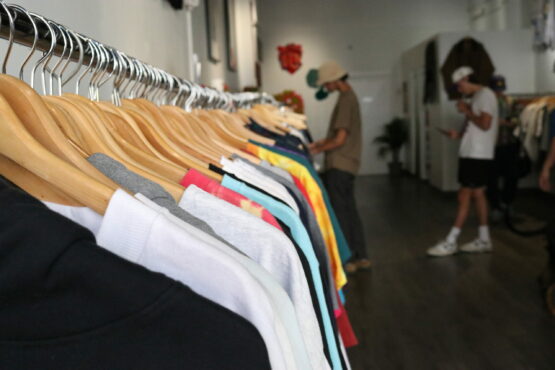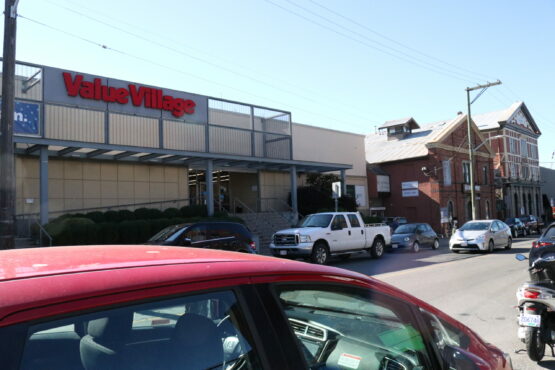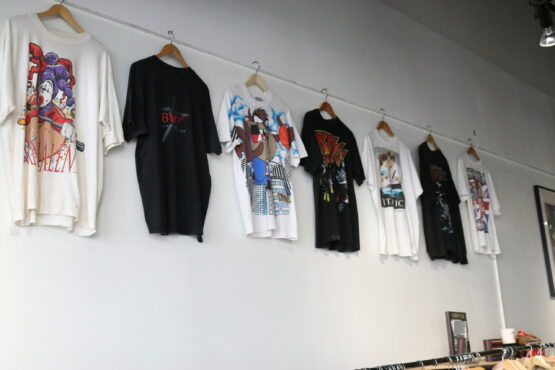Are Victoria’s resellers gentrifying thrift stores?

Photo by Melody Powers.
At 9 a.m., the heavy metal doors start to open slowly. The once-joking men stop their conversations and start to pile into Value Village. The door-greeter sanitizes each of their hands before they sprint off in every direction. The fluorescent lights beam down, employees stand off to the sides, and the aisles of clothes have been restocked with hidden gems waiting to be discovered.
Julio Martelino darts towards the men’s sweater section. He scans each rack like it’s a competition — because it is. He spends a maximum of 30 seconds on each rack before heading on to the next, picking up items as he goes. He runs to the next aisle and does the same. The metal screech of hangers dragging across the racks echoes throughout the building.
He passes his friends, now competitors, in the aisles. They yell out to each other about their finds but do not stop to talk. After 15 minutes of frantic activity, the entire store starts to settle, the employees come out from the sidelines.
Martelino heads to the shoe section and finds his 16-year-old friend, Jake, holding a pair of Ravenclaw Doc Martin rip-offs. Jake makes a joke about how ugly the pair of shoes is as Martelino displays his finds. Oliver Coyle, Martelino’s friend and business partner, comes over.
The friends discuss their finds, debating which to keep and which to put back. They analyze every detail of the clothing — the colour of the tags, the cuffs of sweaters, measurements — and they Google how much the items would cost on resale websites such as Grailed and Depop.
This race in Value Village is the everyday morning of a clothing reseller.
Since the beginning of the pandemic in 2020, thrift shopping has hit an all-time high. According to reporting by the Globe and Mail, 36.2 million people shopped second-hand for the first time that year compared to 16.4 million in previous years. With this rise in second-hand shopping, there has also been an increase in people reselling clothes to make a profit on the side, and people making full careers out of it.
While many see thrifting as a sustainable approach to fashion, some advocates argue that thrifting and reselling are gentrifying thrift stores and taking clothes away from people in need.
Growing up thrifting
As a kid, UVic student Joelene Brewer spent most Sundays hitting garage sales with her father. For Brewer, this was not only a fun Sunday hobby for her and her family, but also a necessity, as it is for many other Canadians who cannot afford everyday items.
“Growing up, we always thrifted pretty much anything that could be [bought] second-hand,” Brewer says, wearing a cropped AC/DC shirt and a long yellow skirt, both items thrifted.
Raised in a family of five during the 2008 recession, Brewer and her family shopped at stores like Value Village for clothes. They also scanned neighbourhoods for pieces of furniture on the side of the road that they could repair and repurpose.
Brewer remembers being 12 and endlessly scanning the racks of Value Village, looking for popular name-brand clothes and trying to find the perfect outfit so she could avoid being outcast by her peers.
“I remember feeling a little bit of shame and embarrassment being younger and thrift shopping,” she says. “I would be thrift shopping, and … I [felt] like ‘I visibly don’t have the money.’”
Brewer recalls that she wished she could have shopped in malls and bought name-brand clothing like her classmates. But in 2018, she got a job at a popular thrift store in Langley called Talize, and that’s when her views on thrift stores started to shift.
“The year that I started working at the thrift store, I transferred schools to a fine arts school,” she says. “There were a lot of wealthy kids that went to this school, and I remember feeling kind of shocked that I would see so many of these people repeatedly at the thrift store.”
Second-hand reselling has also grown in popularity as apps like Depop, Poshmark, Grailed, and even Instagram make it accessible to buy second-hand clothing in the comfort of your own home. Even Brewer admits to having sold a few vintage finds for a little extra cash.
“I think a lot of people don’t know that an item will get recycled if it’s not sold,” Brewer says. “I don’t feel too guilty buying something second-hand and reselling it if I know that it can be recycled and then no one gets to have it.”
As reselling and thrift shopping have become popular, arguments claiming that thrifting and reselling are gentrifying thrift stores are also rising, leaving many people to question the ethics of second-hand shopping and reselling.
“Objectively, I think it’s something we should all be moving towards, in an environmental way,” says Brewer. “I don’t think that people moving towards thrifting alone is what made thrifting so expensive. These stores know they can charge people more because there’s more people buying.”
Eliciting hate comments
Vlogs called “Thrift Hauls” or “Come Thrift With Me,” videos where teenagers and young adults film themselves thrift shopping, circulate throughout TikTok and other social media. These kinds of videos can gain around 100 000 to even millions of views, but arguments that flare in the comment sections aren’t all favourable.
Hate comments like “God I hate people like you,” or “you’re one of those people” are becoming common on popular thrifting vlogs, and can gain thousands of likes. These comments are emerging after online arguments claim that the rise of thrifting and resellers are gentrifying thrift stores and making it harder for lower income folks to find good clothes for cheap.
The other half of the argument is in favour of thrifting and resellers. Previously, the Martlet reported that “fashion is responsible for nearly 20 per cent of global wastewater and 10 per cent of global carbon emissions.” The negative effects of the fast fashion industry have motivated people to turn to thrifting as a sustainable alternative.
These conflicting arguments raise the question: is the rise of thrifting taking away from lower income individuals or is it a solution to the environmental devastation of fast fashion?

Value Village thrift store. Photo by Melody Powers.
The history of thrifting
Thrift stores in America started in the late 19th century during the industrial revolution. During this time there was an introduction of mass clothing production, according to a 2018 article from Time. Clothes started to get more affordable and more disposable, triggering the creation of consignment stores as a way to recycle clothing that was tossed away.
In Canada, thrift stores started to gain popularity in the 1980s. By the ‘90s thrift stores had started to open up in malls, according to CBC. But in 2020, the second-hand market really started to boom, with the market reaching a record high of $35 billion in 2021. It’s expected to double, reaching $82 billion by 2026, according to ThredUP’s 2022 resale report.
Other than the rise of TikToks, thrifting has become popular among Millennial and Gen Z generations as a way to stop supporting the fast fashion industry. Fast fashion is known for its unethical treatment of workers, with 170 million children estimated to be engaged in child labour.
The argument against the rise of thrifting and reselling comes down to the idea that people who are buying clothes at thrift store prices and reselling them to make a profit are reducing the already limited options for people who need them. Thrift stores were created to serve the lower-income community, but the popularity of thrifting is dramatically increasing foot traffic, and potentially increasing the prices at thrift stores.
Dr. Marlea Clarke, a UVic associate professor studying labour and environmental consequences of fast fashion, says this isn’t necessarily true.
“[Thrift stores] have more clothes than they can sell,” Clarke says. “So far, the trend of [people buying from thrift stores] and reselling them is not reducing the stock that second-hand stores have to then sell.”
According to a 2018 article from CBC, only half of the donations to thrift stores, such as the Salvation Army, end up on the racks and only half of that is sold. This means only 25 per cent of donated clothing is sold in thrift stores. The rest of the clothes are either sold to different countries, or sent to recycling warehouses, where it’s either made into rags or sent to landfills.
“For gentrification of thrift stores, I’m not sure I’m seeing it,” continues Clarke. “It’s extremely unlikely that now, or in the next five years, we’re going to see rising prices in second-hand thrift stores … so much so that lower-income folks won’t be able to go into thrift stores and still buy clothes.”
Non-profit thrift stores, such as the Salvation Army, aren’t seeing a major difference since the rise of thrifting and reselling either.
“I haven’t noticed any change in the amount of clothing being sold, [and] the prices remain consistent throughout,” says Lisa*, the manager at a local Salvation Army.
For local non-profit organizations, there are options for people who need to get the clothing they deserve and an endless supply of clothing to choose from. According to their annual 2020–2021 impact report, the Salvation Army provided just over 11 400 vouchers to people in need across Canada, free of charge.
“We put out about 600 units [of clothing] every day of the week, six days a week,” says Lisa. “There’s always an ample selection for every demographic and every income level that comes into the store. There’s always enough for everyone to go around.”
Another argument that people against resellers are making online comes down to the prices people are selling their thrift finds for. A reseller can find a $5 or $10 shirt on the racks of thrift stores and, depending on the shirt, can resell it for $100 or even $200. In some rare instances, vintage shirts can even sell for $6 000, as a vintage Aladdin shirt did in 2020.
“If [people] can buy old clothes from a vintage store and sell them online for a whole bunch more, well that’s them being entrepreneurs,” Clarke says.
For some people, paying hundreds to even a thousand dollars is worth it to gain another piece for their collection.
“It’s kind of [crazy] that people pay so much money for certain clothes,” says Martelino. “But that’s with everything. Even some stamps can go for a lot, or baseball cards that are really rare.”

Vintage shirts. Photo by Melody Powers.
Inside the life of vintage resellers
Martelino sits down at a local coffee shop wearing a vintage ‘90s Nike shirt, a jacket he made from old, recycled Carhartt pants, with a matching handmade Carhartt tote bag. Martelino is a 26-year-old UVic chemistry graduate and a vintage reseller in Victoria.
For the past year, Martelino has dedicated his time to thrifting and reselling. His Instagram @julios.yard is ever-growing, gaining over a thousand followers within the span of a year. His feed is filled with vintage sweaters and shirts he found at local thrift stores like Value Village and Salvation Army. His TikTok is splattered with videos of “Thrift Hauls,” some gaining over 300 000 views.
But Martelino didn’t always know he wanted to be a vintage reseller.
“I was working at a thrift store towards the end of my degree at UVic,” says Martelino. “I started reselling the clothes I was buying at the thrift store and I started making more money reselling the clothes than I did working.”
In 2019, Martelino graduated from UVic with plans of attending school for dentistry. But in 2021 he had to make the decision to either continue school or quit everything and pursue a career in reselling.
“At the end of the day, I decided to do [reselling],” says Martelino.
Since pursuing a career in reselling, Martelino has made this his full-time job, making just enough to live off of.
“It’s really hit or miss … right now, though, it’s kind of stressful.”
After only a year of reselling clothes, Martelino opened a consignment clothing store in downtown Victoria with another popular reseller, Oliver Coyle. Their store is called Second Degree Vintage, an inside joke to the owners as they were both UVic science graduates.

Julio Martelino and business partner Oliver Coyle at their store Second Degree Vintage. Photo by Melody Powers.
Since growing his business, Martelino has seen the online arguments against resellers like him.
“I’m just trying to survive,” Martelino says. “I’m not rich by any means. I could probably make … around the poverty line just from reselling … We’re particular in what we pick [at thrift stores]. We only take certain things. There’s still so much more for other people to take.”
The future of second-hand
Back at Value Village, another thrifting day is about to begin. A group of men stand around outside of the building half an hour before the doors open. The Victoria rain sprinkles down on them; they’re protected by their thrifted Arc’teryx raincoats. The lineup is broken up into different groups of resellers.
Martelino stands around in a circle with other clothing resellers and his personal friends, they’re all laughing and making jokes with one another.
“Half the reason we come here so early is to talk about thrifting,” Jake, another Victoria reseller, says.
“It’s a nice social thing,” says Martelino.
But even though the rise of thrift shopping is keeping more unwanted clothing out of the landfills, there hasn’t been a real decrease in clothing consumption in the fast fashion industry.
“The negative part of [thrift shopping] is it’s not making a real dent on the consumption of new clothes,” says Clarke. “We’re not seeing a parallel decrease in consumption of new clothes at the same time we’re seeing an increase [in] consumption of second-hand clothes.”
Even though reselling and thrifting hasn’t made a dent in overall consumption, it is creating jobs for young entrepreneurs, like Martelino and many other local resellers here in Victoria.
“It doesn’t feel like [I’m doing] a lot,” says Martelino. “At least I’m starting my own business.”
*Last name omitted to protect identity.








